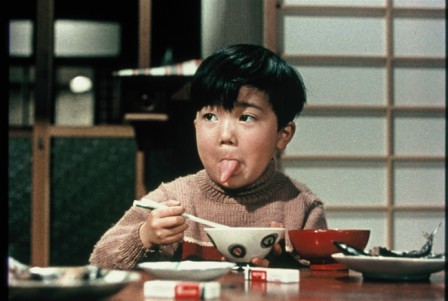Although this decade’s Sight and Sound poll caught the headlines due to Vertigo’s ascent to its perilous dizzy heights, it was Yasujirô Ozu’s 1953 classic Tokyo Story that quietly crept up the charts. Rated 3rd by the Critics and 1st by the polled directors, Tokyo Story is a sombre, meditative film, following an elderly couple’s journey to the capital as they plan to stay with their grown-up children. However, faced with what seem like more pressing matters, the children are too busy and the parents are shunned; that is, by all except their widowed daughter-in-law (played by Ozu regular Setsuko Hara). In spite of her burgeoning commitments she requests time off work, taking the couple sightseeing before they return home. The film tiptoes towards a melancholic conclusion and, quite suddenly, it becomes apparent that what you are witnessing is a very special cinematic experience.
Strip away the plot and Tokyo Story bears all the hallmarks of Ozu’s work: static and unobtrusive camerawork, often focusing on empty interiors or facades, sharp cuts from one scene to the next, the director’s trust in a selection of recurring actors and an incredibly slow pace. But don’t let that put you off. Sitting at 136 minutes, it is exactly as long as this year’s reboot of the Spiderman franchise. It is also a much better film, pulling the viewer in and then revealing to us our deepest, hidden concerns over those not-so-far-off days when our parents will inevitably pass away. Ozu has been called “the poet of family life”.
What Ozu has, that hundreds of other directors do not, is a personal cinematic language. From the first scene to the last, watching an Ozu film really is like entering a new world. His signature pillow shots, for instance, are truly idiosyncratic. But that’s not to say that Ozu’s films are distant or too exotic. Like other Japanese masters Mizoguchi (The Story of the Last Chrysanthemums) and Kurosawa (Seven Samurai), Ozu’s films have a duality that is ‘oriental’ and, quite simply, human. Critics of his work say that he only ever really made one film. But the ceaseless examination of families, wrapped up in social realism and drama, is revolutionary rather than restrictive, passionate rather than dull.
Among the director’s other films (he made 53 altogether, 26 of those in his first five years working in the industry!) are Late Spring (1949) and Early Summer (1951), both of which are heartbreaking stories about the role of women in post-war Japan. Many of his earlier silent works have been lost. However my own personal favourite is his satire of small-talk: Good Morning (1959). Filled to the brim with fart-gags and never-ending cuteness, this loose remake of his 1932 existential comedy I Was Born, But… pokes fun at our attempts to make language meaningful. The two protagonists realise that in order to get the television they so desperately want, their best bet is going on a language-strike.

Similar to much of Ozu’s back catalogue, Good Morning is engaged with Japan’s – and the world’s – post-war globalisation and what impact that has on tight-knit family units. From silent film to talkies and monochrome to colour, this profound, poetic use of cinema is important but nevertheless very watchable. Ozu once claimed: “I just want to make a tray of good tofu. If people want something else, they should go to the restaurants and shops.” One thing is for sure, Ozu made some damn-fine tofu.
First published in Leeds Student (2012): http://www.leedsstudent.org/2012-10-12/ls2/arts/a-closer-look-at-ozu


